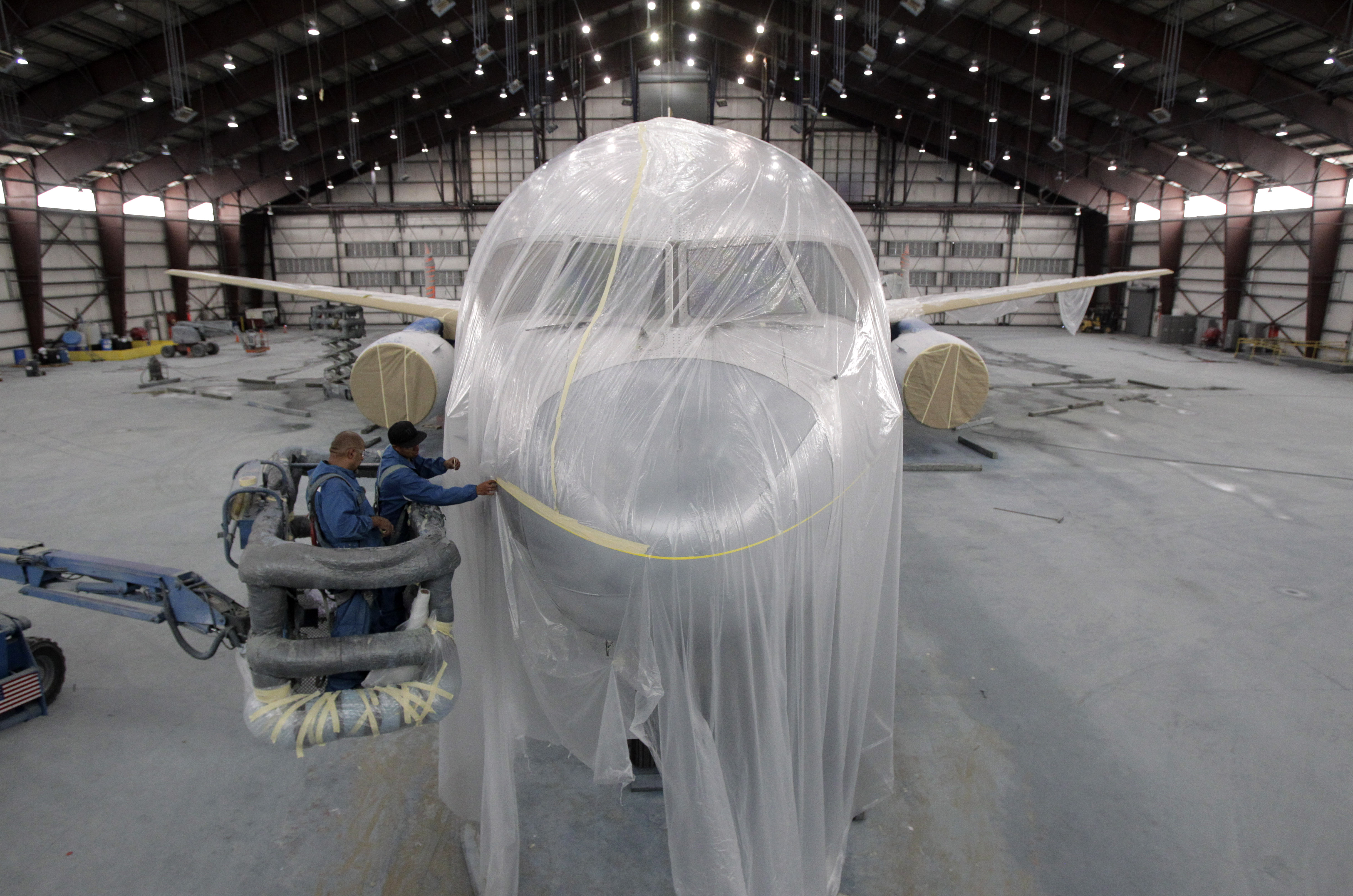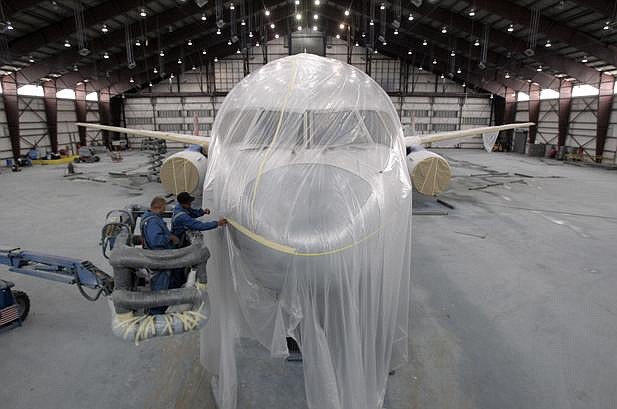 Two painters mask a United Airlines passenger jet as they prepare to paint the plane at Leading Edge Aviation Services' painting facility in Victorville, Calif. Once a boomtown where housing came cheap, this remote desert city far east of Los Angeles is now a poster child for an economic hangover that just won't quit: One in 59 homes is in foreclosure and unemployment hovers near 14 percent. Yet residents see an end to their tale of woe in the misfortunes of others.
Two painters mask a United Airlines passenger jet as they prepare to paint the plane at Leading Edge Aviation Services' painting facility in Victorville, Calif. Once a boomtown where housing came cheap, this remote desert city far east of Los Angeles is now a poster child for an economic hangover that just won't quit: One in 59 homes is in foreclosure and unemployment hovers near 14 percent. Yet residents see an end to their tale of woe in the misfortunes of others.By GILLIAN FLACCUS
Associated Press
VICTORVILLE, Calif. - The billboard outside the Arbor Lane subdivision offers a hollow promise of elegant homes at rock-bottom prices.
A drive down the flag-lined entrance reveals the truth: Empty lots filled with weeds swallow up the several dozen completed houses. Winding cul-de-sacs lined with extinguished street lamps dead-end in piles of dirt and dried grass. Nothing resembles an arbor.
Four years after the housing bubble burst, this once-booming desert city far northeast of Los Angeles is nursing an economic hangover that won't quit: one of 67 homes is in some stage of foreclosure, unemployment is nearly 17 percent and the busiest place in the threadbare historic downtown is a thrift store attached to a food bank.
Yet beyond the foreclosure signs and graffiti-stained windows, a long-decommissioned air force base offers a glimmer of hope. Two decades after George Air Force Base shut down, taking hundreds of jobs with it and leaving runways and hangars empty, the redeveloped base is taking off as a hub for commercial aviation, freight shipping and logistics.
United Airlines recently contracted with Leading Edge Aviation Services Inc. to repaint 650 commercial airliners in massive hangars after a merger with Continental. Dr. Pepper/Snapple opened a sprawling distribution hub that serves the Western U.S. and parts of Asia. Airplane maintenance company ComAv wants to build a hangar complex on the base for heavy airplane maintenance, a move that would create up to 3,000 new jobs, said Mayor Ryan McEachron.
Victor Valley College recently began an on-site classroom to train locals for aviation-related jobs and can't graduate enough students to meet the demand, said Peter Allan, a professor of business and economics. Many of the students work in the morning and attend classes in the afternoon.
The new business complements a roster of aviation, logistics and shipping businesses that moved into the space early on and has given the 8,500-acre redevelopment project more of the buzz it needs to lure other big companies, said Keith Metzler, the city's director of economic development and director of the Southern California Logistics Airport, part of the base redevelopment.
Ultimately, Victorville wants to use its position near a web of freeways and rail tracks to develop an "inland port" at the base that disperses goods arriving by ship in Los Angeles to points all across the U.S. by train, truck and plane.
"The gratification you get is when you start hearing the stories (of the unemployed being hired) in the community," said Metzler, who has worked for years to revitalize the facility.
The city's push to revitalize the old air base, which is now divided into a commercial airport and an industrial complex, won't reverse Victorville's economy by itself, but it tackles head-on the biggest problem in a region that epitomized the excesses of the housing bonanza: a booming population with no jobs to support it.
Victorville, a high desert city separated from its coastal neighbors by the San Bernardino Mountains, began to stir in 2004, when housing prices spiraled out of reach of middle-class families in neighboring Los Angeles and Orange counties. Homebuyers began flocking to the rural Victor Valley, snapping up homes in shiny new developments for a fraction of what a similar home would cost "down the hill."
The city's new residents were happy to commute from the dusty expanses of the high desert hours in exchange for home ownership and Victorville soon found itself the second-fastest growing city in the nation.
Residents say shady lenders contributed to the boom, skirting the rules to offer cheap loans to families who couldn't afford them - and when the bubble burst, Victorville, population swollen to 115,000, fell hard and fast.
In some parts of the city, the foreclosure rate in June reached one in 38 homes, according to data from RealtyTrac, a company that maintains a nationwide database of foreclosures. Statewide, one in every 248 homes was at some stage of foreclosure last month; nationally, that number jumped to one in 583 homes.
State records show Victorville's jobless rate in June was 16.8 percent - roughly twice the national rate - and hundreds of desperate families flock to the city's main food pantry seeking out food, bus passes and help with utility bills.
At the height of the housing boom, Raul Ramirez Jr. oversaw plumbing work at 120 homes in four new housing developments. He's been unemployed four years now and has applied for more than 100 jobs with no luck. He recently began applying to U.S. military contractors working in Iraq.
"It's really a sad thing, being where I was four years ago and being where I'm at now and I'm not the only one who's like that," said Ramirez, as he waited in line for free groceries and a bus pass at Samaritan's Helping Hand food pantry. "If something doesn't pick up soon, I don't know if it will ever recover."
Leading Edge Aviation Services Inc., a specialty aviation company expanding rapidly at the old base, wants to be a part of the hoped-for recovery.
When the company announced it had a $100 million contract to paint hundreds of commercial airliners as part of the merger between United and Continental, more than 1,200 people applied in five days, said Pete Robertson, the company's general manager. The company's Victorville location has more than doubled its workforce since last year and now runs two 10-hour shifts every day.
The company can work on three wide-bodied jetliners at once in sprawling hangars that glow a blinding white in the hot desert sun.
On a recent summer day, more than a dozen employees in protective suits and respirators swarmed around a 767-300 airliner. Men in giant cherry pickers navigated along the sides of the giant plane to gently sand and buff the surface.
Wings that span nearly half a football field were shrouded in plastic to protect them from paint and massive engine turbines were cloaked in brown paper with tape.
Leading Edge's expansion is welcome news, but those who work with the jobless daily don't think the activity at the former base can pull Victorville out of its slump.
Robin Schlosser, who runs the food bank, said her staff has provided assistance to 18,000 people this year and more keep coming - a reality check amid talk of a few hundred new jobs here and there.
"We need to have a huge expansion in order to have that glimmer of hope," she said. "The reality of it is, we need thousands of jobs. There's still not enough to meet the demand for the number of people living here and we still have families moving in because of affordable housing."
For Jon Mauro, a plane-painting job at the former base has been the answer that so many of Schlosser's customers seek.
Mauro was laid off from a job laying cable after the housing market crashed and spent more than a year on the unemployment rolls. The 24-year-old now supervises letter stenciling on emergency exits, tails and other parts for Leading Edge.
"I was going out every day, looking on the Internet, putting out applications anywhere I could," Mauro said. "I hope to keep this job for a long time."
